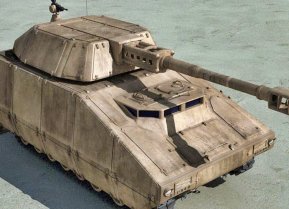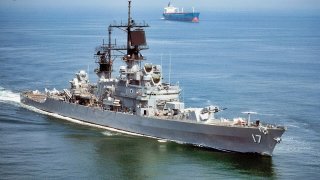The Navy's Leahy-Class Missile Cruisers Were Loaded with Weapons
Initially designated as Destroyer Leaders, Leahy-class vessels were later reclassified as guided-missile cruisers in the mid-1970s.
Meet the Leahy-Class Cruisers of the U.S. Navy - The concept of a “double ender” dedicated escort missile frigate first derived following the Second World War, when the U.S. Navy’s Baltimore and Cleveland-class ships began conversion processes into hybrids. By the 1950s, the service understood the need for a first generation of missile cruisers capable of protecting an entire carrier task force. Since tensions between the U.S. and the Soviet Union were brewing amidst the rise of the Cold War, there wasn’t enough time for the Navy to wait around for future ships to be constructed to fulfill this requirement. In fact, a new generation of tailored cruisers was not expected to enter service with the Navy for four or five years minimum. To rectify this barrier, the service decided to take a shortcut and simply convert older ships.
Introducing the Leahy-Class Cruisers
Initially designated as Destroyer Leaders, Leahy-class vessels were later reclassified as guided-missile cruisers in the mid-1970s. As the new “double-ender” class, the Leahy ships were equipped with Terrier missile launchers at the forward and aft. Notably, these vessels were the first frigate class to be developed without a main gun battery for shore bombardment. The Convair RIM-2 Terrier was one of the earlier surface-to-air missiles fitted on U.S. Navy ships. Designed to provide a middle layer of defense against air attack, the Terrier became mightily significant for the safety of strike groups. Following the Second World War and the Japanese attack on Pearl Harbor, the installation of the Terrier on Leahy ships was prioritized.
Leahy-Class Ships Well Armed
The Leahy-class functioned similarly to their Farragut-class predecessors. Its main task was to form part of the anti-air and anti-submarine screen necessary for carrier strike groups, while simultaneously controlling aircraft from the carrier by providing vectors to target.
In the late 1960s, the Leahy ships underwent several upgrades and each ship was given an AAW enhancement with Terrier launchers modified to launch both Terrier or Standard SM-1ER missiles.
The guns fitted on each ship were also replaced by eight Harpoon missiles. As detailed by Seaforces, the New Threat Upgrade program, including combat system capability improvements to Air Search Radars, Fire Control Radars, and Combat Direction System was also installed on the Leahy ships in the 1980s.
The New Threat Upgrade enabled the cruisers to coordinate the engagement of multiple targets with SM-2 Extended Range missiles.
An Overview of the Cruiser Class
The first Leahy cruiser, commissioned in 1962, was followed by eight subsequent ships: The Harry E. Yarnell (CG-17) in 1963, the Worden (CG-18) in 1963, the Dale (CG-19) in 1963, the Richmond K. Turner (CG-20) in 1964, the Gridley (CG-21) in 1963, the England (CG-22) in 1963, the Halsey (CG-23) in 1963 and the Reeves (CG-24) in 1964.
The first three Leahy-class ships were built at Bath Iron Works, while the rest were constructed at New York Shipbuilding Corp, Puget Sound Bridge and Dry Dock Company, Todd Shipyard, and Puget Sound Naval Shipyard.
After completing a shakedown cruise shortly following her commissioning, USS Leahy made two six-month deployments to the Mediterranean Sea over the next few years. When the ship was decommissioned in 1967 to undergo her first modernization package update, the Naval Tactical Data System and other radars were installed. Following this major overhaul, the Leahy became the first American warship to visit Leningrad since the mid-19th century and the first American warship to visit the Soviet Union since the Second World War.
Though the Leahy-class ships served the Navy honorably in their years in service, they were prematurely taken out of commission in the early 1990s as part of the Clinton Administration’s objective to minimize defense spending amidst rising tensions with Russia.
Between 1993 and 1995, all Leahy-class cruisers were taken out of service and transferred to the Maritime Administration for disposal.
About the Author
Maya Carlin is an analyst with the Center for Security Policy and a former Anna Sobol Levy Fellow at IDC Herzliya in Israel. She has by-lines in many publications, including The National Interest, Jerusalem Post, and Times of Israel. You can follow her on Twitter: @MayaCarlin.


